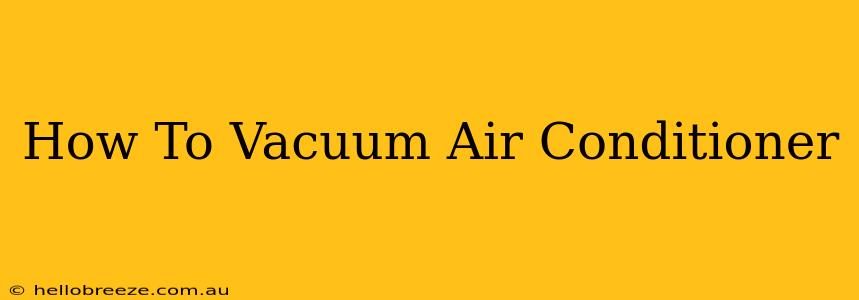Keeping your air conditioner running efficiently isn't just about changing filters. Did you know that a build-up of dust and debris inside your AC unit can significantly reduce its cooling power and increase energy consumption? Vacuuming your air conditioner is a crucial, often overlooked, step in maintaining its performance and extending its lifespan. This guide will walk you through the process, ensuring you get the coolest, most efficient air conditioning possible.
Why Vacuuming Your AC is Essential
Dust, dirt, pollen, and other airborne particles accumulate within your air conditioner over time. This build-up restricts airflow, forcing your unit to work harder to achieve the desired temperature. This increased workload leads to:
- Reduced Cooling Capacity: Your AC struggles to cool your space effectively, leaving you feeling uncomfortable.
- Higher Energy Bills: The unit consumes more electricity to compensate for the restricted airflow.
- Shorter Lifespan: The strain on the components accelerates wear and tear, potentially leading to premature failure.
- Poor Air Quality: Dust and debris circulating within the unit can be blown into your living space, impacting indoor air quality.
What You'll Need
Before you begin, gather the following tools:
- Vacuum Cleaner with a Crevice Tool: A crevice tool is essential for reaching narrow spaces within the AC unit. A shop-vac with a powerful suction is ideal.
- Soft-Bristled Brush: This helps to gently remove loose debris before vacuuming.
- Screwdriver (possibly): Depending on your AC unit's design, you may need a screwdriver to access certain components.
- Protective Gear: Consider wearing safety glasses and a dust mask to protect yourself from dust and debris.
Step-by-Step Guide to Vacuuming Your Air Conditioner
Safety First! Always unplug your air conditioner from the power source before starting any cleaning or maintenance.
-
Prepare the Area: Clear the area around your air conditioner to provide ample working space. Spread a drop cloth or old newspaper to prevent scratching or damaging the floor.
-
Access the Fins: Carefully inspect your air conditioner's exterior fins. These are the thin metal slats that allow air to pass through the unit. Use a soft-bristled brush to gently remove loose dust and debris. Be very careful not to bend or damage the fins. Bent fins can severely restrict airflow.
-
Vacuum the Fins: Using the crevice tool attachment on your vacuum cleaner, carefully vacuum the exterior fins. Work your way across the entire surface, paying attention to any areas where dust or debris has accumulated. Use gentle, sweeping motions to avoid bending the fins.
-
Clean the Internal Components (If Accessible): Some air conditioners allow access to internal components. If yours does, carefully remove any accessible panels and gently vacuum the interior, focusing on the fan and any other areas where dust has collected. Refer to your air conditioner's manual for specific instructions.
-
Inspect and Clean the Filter: While you're at it, check and clean or replace your air conditioner's filter. A clogged filter restricts airflow, even more than the accumulated dust on the fins.
-
Reassemble and Test: Once you've finished vacuuming, reassemble any removed panels and plug your air conditioner back into the power source. Turn it on and check for any improvements in airflow and cooling performance.
Maintaining a Clean Air Conditioner
Regular vacuuming is a key element in maintaining a clean and efficient air conditioner. Aim to vacuum your AC unit at least once a month during peak usage seasons (summer or winter, depending on your climate and whether you use it for heating as well) and at least every three months at a minimum. This simple maintenance task will significantly extend the life of your appliance and save you money on energy bills in the long run. Remember, prevention is better than a costly repair!

